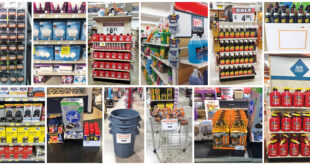Looking Forward: Discover more home improvement insights from HIRI at hardwareretailing.com/hiri-deceleration.
Paint, particularly interior wall paint, has long been a go-to for many DIYers. With one of the highest DIY purchase incidences across home improvement categories, paint remains a constant in strong or weak markets. Every other year, the Home Improvement Research Institute (HIRI) conducts research with homeowners on over 200 individual products, including 23 paint and sundry products.
While paint and sundries have historically been one of the most purchased home improvement categories, the pandemic gave it an even larger boost that resulted in record-high consumer sales volumes. DIY homeowner purchase incidence of interior paint among DIYers jumped from 5% pre-pandemic to 27% post-pandemic. Boomers had a higher purchase incidence of paint and sundries (39%) than younger generations (24% among Gen X, 27% among Gen Y), which is something not often seen in other DIY categories since younger generations are typically more engaged in DIY projects.
HIRI also provides its members with regular product market size and forecast data, and when it comes to paint and sundries, the impact of so many DIYers picking up a paintbrush over the past two years is noticeable. HIRI forecasts 2023 consumer product sales for paint and sundries to slightly decrease 0.3% over 2022’s sales, but it could be argued that maintaining such high 2022 consumer sales is an achievement. HIRI forecasts 2023 pro product sales for paint and sundries to increase 4.6% over 2022. While these are not the double-digit gains seen in 2021 and 2022, they do represent a more historically competitive environment and demonstrate more opportunities among contractors.
Beyond 2023, paint may benefit from lower mobility rates seen among homeowners over the past 10-plus years. Today, the average homeowner stays in their home for 12.3 years, according to Redfin’s analysis of historical county records. That figure is expected to increase as homeowners face few options to relocate due to the low existing home supply of roughly 3 months, according to the National Association of Realtors. Average stays will also jump because of a sharp and a sharp increase in mortgage rates that’s keeping owners with low rates in their homes, which is being coined the “lock-in effect.” As more homeowners stay put, they may once again look to paint to provide their homes with a fresh look.

In Case You Missed It: For a broader view of the state of the independent home improvement industry, read insights from the 2023 Market Measure Report at YourNHPA.org/market-measure.

Interior coatings can bring an immediate facelift to any room with a small investment. Paint is affordable, which addresses the No. 1 home improvement challenge among DIYers and DIFMers today.
Paint is also a necessity for those completing a larger remodel. HIRI conducts quarterly project activity research among homeowners, where kitchen and bathroom projects are regularly in the top three projects completed or planned. Over 40% of homeowners who completed a kitchen or bath remodel did some painting as a part of that project.
Big project or small, low or high budget, paint and sundries can be a solution well-suited for many occasions. While sales may be stable in 2023, homeowners may grow wary in a few years of their recent paint projects. Paint remains well positioned for growth in existing homes and new housing once new housing starts regain strength in 2024 or beyond.
“Paint is affordable, which addresses the No. 1 home improvement challenge among DIYers and DIFMers today.”
—Home Improvement Research Institute

Research for Your Business
The Independent Retailer Index, developed with the North American Hardware and Paint Association and The Farnsworth Group, is a regular measure of the independent channels’ performance. Access data at YourNHPA.org/retailer-index each quarter. All data is presented in aggregate. The Index tracks quarterly and year-over-year changes in various business areas including:
- Total sales
- Transaction count
- Inventory investment
- Cost of goods
- Gross profit margins
- Future expectations
- Investment plans: inventory, staff, property, plant and equipment
 Hardware Retailing The Industry's Source for Insights and Information
Hardware Retailing The Industry's Source for Insights and Information









